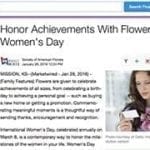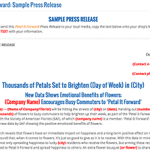Can Women’s Day — already an established holiday in many other countries — become a big deal in the U.S.?
That’s a question many Society of American Florists members are still pondering, several weeks after the March 8 observance.
This year, 48 percent of respondents to an SAF Women’s Day survey said they promoted the day to their customers; 44 percent did not. (And 7 percent of respondents said they themselves were in the dark about the holiday.)
Those results indicate a 11 percent bump in participation in the holiday compared with 2015 returns, when 43 percent of respondents promoted Women’s Day and 51 percent did not. (Seven percent said, “Women’s Day? What’s Women’s Day?”)
About a third of respondents to this year’s survey said the number of orders they received was about even with 2015 transactions; 16 percent experienced an increase in the number of orders.
Meanwhile, about 28 percent said sales were about on par with 2015 returns. About 18 percent said they increased, and 8 percent saw a drop. (About 47 percent said the question was not applicable to them.)
The challenge, according to a number of respondents, is that the March 8 date places the holiday between Valentine’s Day and Mother’s Day, and many consumers just aren’t aware of Women’s Day — or how the day is different from those other events. (Women’s Day is a celebration of all women, not simply romantic partners or mothers — and former Floral Management Marketer of the Year winner Lane DeVries has argued that the late winter date is an attribute, not a drawback.)
That doesn’t mean some florists didn’t try to raise awareness. Flower giveaways, contests and partnerships with charities were popular efforts, according to the survey.
In Ontario, one shop held an in-store event with mimosas, to benefit local community shelters. (Attendees were asked to donate feminine products.) And a Maryland shop ran a contest, asking people to “talk about a woman who inspired them… We drew a name and sent an arrangement . took a picture of her with her flowers and posted that on Facebook.” (Read about other florist promotions for this year’s event.)
To drum up awareness, social media was by far the most popular promotional tool, with about 67 percent of respondents using Facebook, Twitter, Instagram and blogs. About 40 percent used store signage, posters or displays. Almost 40 percent used online advertising and about 36 percent used email promotions, among other, less popular efforts.
Overall, about two-thirds of respondents said they filled fewer than 10 Women’s Day orders.
The relatively low number begs the question: Can Women’s Day grow? About 37 percent of respondents said they think the day has potential. About 40 percent said they do not.
Last year, the response was similar, with about 34 percent of respondents saying they thought the holiday can grow, and 39 percent saying they did not see potential. (The remainder said “maybe.”)
“I would love to say yes,” Women’s Day has potential, “but it’s going to take a lot of promotion,” to raise awareness to a significant level, said one Wisconsin respondent this year.
A respondent in Boston was more optimistic. “The potential is there for strong growth on this holiday,” he wrote. “Greater press recognition and consumer education about this holiday will yield better sales. Rome wasn’t built in a day!”
Survey results this year remained fairly consistent across business size and geographic location. One factor, though, clearly helped: proximity to international communities.
“Most of sales were from ethnic men who were very specific about selecting large flowers,” one respondent in Massachusetts explained. “I would say 80 percent eastern Eastern European Russian.”
In South Florida a thriving community of Russian immigrants helped buoy business. One customer “bought ? three $500 arrangements for his female staff,” a respondent marveled. “Even when this is factored out, I still did better this year than last by at least 10 percent. I also noticed an increase in public media attention to the holiday.”
The floral industry, of course, is not alone in its effort to make Women’s Day a bigger event in the U.S. In fact, a number of U.S. companies launched high (higher) profile Women’s Day efforts this year. Two stand-out campaigns:
- Microsoft’s #MakeWhatsNext campaign video highlighted the “often undervalued contribution that women inventors have made to science, due to the emphasis often falling on their male counterparts in terms of what children are taught through mainstream school curriculums.”
- Google’s Women’s Day “doodle” celebrated the “aspirations of women from around the world” with a video that asked 33 girls and women from all walks of life to complete the sentence “One Day I Will…”.
Read more about these campaigns and others.






